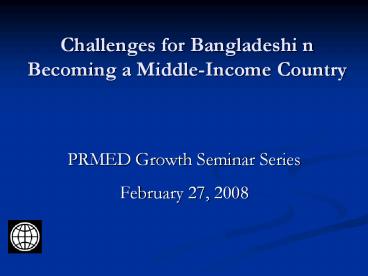Challenges for Bangladeshi n Becoming a Middle-Income Country - PowerPoint PPT Presentation
1 / 27
Title:
Challenges for Bangladeshi n Becoming a Middle-Income Country
Description:
Title: What will it take for Bangladesh to reach the Growth targets needed to achieve the MDGs? Author: wb93427 Last modified by: wb93427 Created Date – PowerPoint PPT presentation
Number of Views:121
Avg rating:3.0/5.0
Title: Challenges for Bangladeshi n Becoming a Middle-Income Country
1
Challenges for Bangladeshi n Becoming a
Middle-Income Country
- PRMED Growth Seminar SeriesFebruary 27, 2008
2
Can Bangladesh Become a Middle-Income Country by
2016?
- Gross National Income per-capita of US470 in
2005 places Bangladesh in the category of
low-income countries as per IDA classification - IDAs threshold for middle-income countries was
US870 in 2005.
3
Can Bangladesh Become a Middle-Income Country by
2016?
- Can Bangladesh become an MIC by 2016?
- Yes, if GDP growth increases to 7.5 a year
- If growth falls to the 3 rate seen in the 1980s,
MIC status will happen after 5 decades
4
Can Bangladesh Become an MIC by 2016?Reasons to
be optimistic
- Good growth record (gt 5) since 1990
- Sound economic fundamentals
- A young labor force demographic dividend
- Established entrepreneurial culture
- Substantial improvements in human development
5
An Impressive Growth Record that needs to be
Strengthened
6
An Impressive Growth Record that needs to be
Strengthened
Per-Capita GDP Bangladesh Vs. Median LIC
Bangladesh
Median LIC
7
Growth Record International Comparisons
8
Growth Matters Over Long-Run
9
Can Bangladesh Become an MIC by 2016?Challenges
to Consider
- Target of 7.5 growth is an ambitious one. Few
developing countries have been able to sustain it - Being an MIC is not just about income levels.
MICs have more complex and sophisticated economic
systems which need to be understood
10
What Explain Bangladeshs Growth Experience?
- Growth acceleration in the early 1990s was
enabled by major policy improvements - macroeconomic stabilization (monetary and fiscal
discipline, and correction of exchange rate
misalignment and of external imbalances) - Easing of trade and exchange restrictions
- Relaxation of restrictions on private investment
in various Industrial Policy Orders - Launching of the Financial Sector Reform Program
(FSRP), deregulating interest rates and
abolishing credit quotas - Further deregulation of agriculture markets
11
What Explain Bangladeshs Growth Experience?
Contd.
- Govt moved early and decisively to avail of
opportunities provided by MFA/ATC quota systems
for garment exports EPZs, bonded-warehouses,
back-to-back LCs etc. - Sharply rising workers remittances fueled
construction and domestic demand - Early emphasis on human development especially
womens advancement proved crucial.
12
Can Bangladesh Become an MIC by 2016?Challenges
to Consider
Sources of Growth
13
Bangladeshs Transition to MIC Status
14
Transition 1 Agriculture to Labor-Intensive
Manufacturing
- Transition 1 implies a deeper labor-intensive
manufacturing base and more productive
agriculture - driven by globally competitive manufacturing
firms productive, diversified, and
commercially-oriented agriculture sector
15
Main Constraints to Deepening Manufacturing Base
- Firm-level analysis suggests that following areas
need particular attention to boost productivity
in manufacturing - Rapidly emerging power supply constraints
- Limited access to FDI for manufacturing
- High remaining anti-export bias
- Deficiencies in worker and mgmt skills
- Limited knowledge economy base
- Concerns over law and order
16
Firm Size and Productivity
17
Transition 2Closed Economy to Globally
Integrated One
- Transition 2 implies judicious, but not
complacent, approach to global integration - Bangladeshi firms plugged into global supply
chains and country figuring prominently on global
investment maps
18
Main Constraints to Deepening Global Integration
- High levels of anti-export bias hurts non-RMG
exports and prevents export diversification - Among the highest trade protection in the world
19
Main Constraints to Deepening Global Integration
20
Main Constraints to Deepening Global Integration
- High levels of anti-export bias hurts non-RMG
exports and prevents export diversification - Among the highest trade protection in the world
- Bonded warehouse facility not available to most
sectors. With dysfunctional DEDO, this
discourages export diversification. - Poor state of trade facilitation inefficient
port and various bottlenecks at customs and
related to connectivity with hinterland
21
Transition 3Rural to Urban
- Transition 3 implies emergence of diverse,
dynamic urban centers, with Dhaka remaining at
forefront of urban activity
22
Managing Rapid Urbanization Key Challenges
- Absence of balance in urbanization no viable
urban alternatives to Dhaka - Dhaka fast reaching choking point
- Rising congestion pressures in Dhaka
- Provision of infrastructure and urban services
far behind demand - Exorbitant real estate prices in Dhaka
- Key issues
- Virtual absence of decentralization
- Lack of devolution of key services to city
governments - Lack of city govts revenue sources and admin.
capacity - Interregional transport and communication
networks underdeveloped
23
Long-Term Transitions
24
Long-Term Transitions
25
Enabling Environment for the 3 Long-Term
Transitions
- Strengthening governance and regulatory
environment - Addressing infrastructure constraints, with a
special focus on power - Addressing acute labor skill shortages
- Creating deeper and more efficient financial
system - Maintaining macro policies and liberalizing trade
26
Key Summary Messages
- Continued strong private investment and labor
force growth will help, but productivity
improvement is key. - Need to implement 2nd generation reforms, and
refocus policy attention toward hitherto
neglected structural areas governance, urban
management, infrastructure (especially power and
ports) and labor skills.
27
- THANK YOU!































